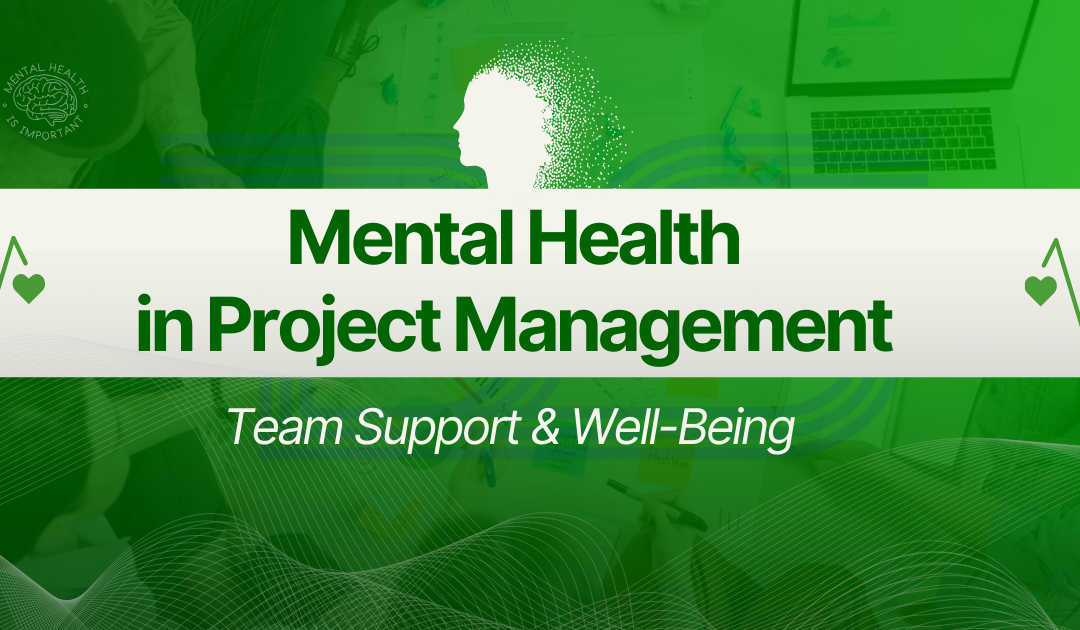
by DharamCW | May 25, 2025 | General, Leadership in Project Management, Personal, Professional Resilience and Inspiration Stories
Project management is a challenging yet rewarding task in the corporate world, requiring multitasking, team dynamics, and timely delivery. Project managers are responsible for enhancing team wellbeing and stress reduction, benefiting both the team and themselves. They can achieve this by providing realistic timeframes, budgets, and fostering high-performing teams. They also monitor team performance to identify signs of burnout and stress, offering coping mechanisms when needed. Project managers must prioritize their teams’ welfare by engaging in their duties to manage projects and lead teams.
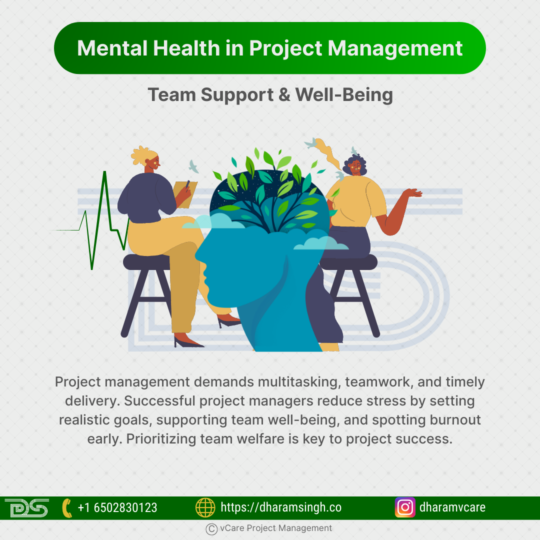
Great project managers don’t just lead projects—they lead people. Supporting team wellbeing drives sustainable success and peak performance.
Project management is a demanding field that requires balancing deadlines, team relations, and excellence. The corporate culture often overlooks the importance of mental health treatment, creating an artificial opposition between vulnerability and toughness. Project managers can model a new leadership culture that prioritizes project success and mental health. This requires a more nuanced definition of resilience, focusing on emotional intelligence, adaptability, and an active attitude towards mental health.
To address this issue, project managers should promote open conversations about mental health and implement policies that enhance team members’ welfare. This article is aimed at project managers and organizations looking to build leadership skills and create a culture where mental health is a key element of success.
Why Mental Health Matters in Project Management?
Mental health is essential in project management since an anxious or burnt-out team will be able to significantly contribute to the failure of a project by causing low productivity, bad decisions, increased turnover, and ultimately, project failure; hence, giving mental health priority in a project team is very important to get best project outcomes.
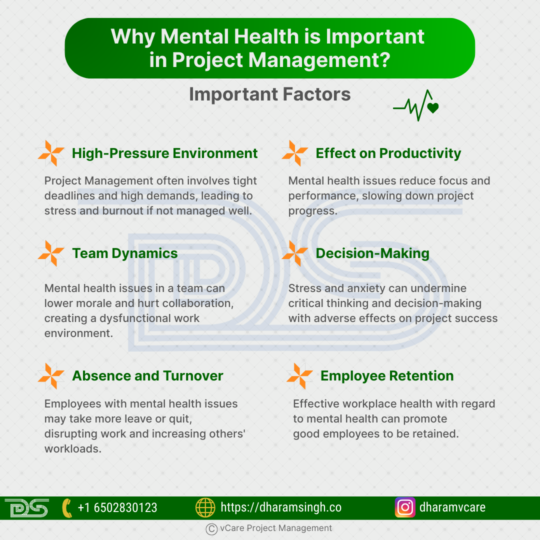
Strong project management starts with strong minds. Learn why prioritizing mental health leads to resilient, high-performing teams.
Important factors why mental health is important in project management:
1. High-pressure environment: Project management is most frequently marked by tight schedules, complicated activities, and high expectations, which readily create burnout, stress, and anxiety if not properly handled.
2. Effect on productivity: When employees are suffering from mental health problems, their attention, concentration, and overall performance are diminished, leading to a deceleration in project progress.
3. Team dynamics: Having an employee with mental issues can ruin team morale and collaboration, leading to a dysfunctional working environment.
4. Decision-making: Stress and anxiety can undermine critical thinking and decision-making with adverse effects on project success.
5. Absence and turnover: Mental illness workers will likely take more sick leave or leave the company, causing disruption to operations and adding workloads to other employees.
6. Employee retention: Effective workplace health with regard to mental health can promote good employees to be retained.
Common Mental Health Challenges in Project Management
Common mental health problems faced by the project managers are stress, anxiety, burnout, depression, and sleep disturbance, typically triggered by problems like tight deadlines, high stakes, complex demands of the projects, scope changes, and inadequate resource allocation, which leave the managers feel overwhelmed and out of control.
Discussions on mental health are becoming increasingly common in the workplace, since 15% of workers between the ages of 18 and 29 believe their mental health is severely bad. 70% of senior staff members lack the requisite training to have conversations with their teams on mental health, according to a recent National Alliance on Mental Illness (NAMI) survey. Also, The World Health Organization estimates that depression and anxiety cause 12 billion lost working days a year, which translates into $1 trillion in lost productivity. This means that an employee’s mental health has a big influence on their company. As a result, workplace mental health has to be given more attention.
The following are some professional mental health risk factors:
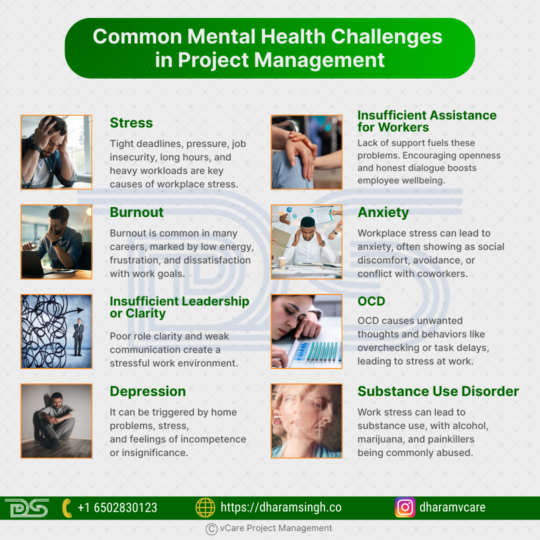
Recognize the warning signs. From stress and burnout to anxiety and OCD—mental health challenges are real and manageable in the workplace.
· Stress – This is the primary cause of poor mental health at work. Deadlines, pressure from supervisors or coworkers, job uncertainty, long hours, and a high workload are all sources of stress.
·Burnout – The majority of employees encounter burnout at some point throughout their career. Lack of drive and enthusiasm, impatience, irritation, and dissatisfaction with work objectives and achievements are all signs of job burnout.
· Insufficient leadership or clarity – A stressful work atmosphere is created when roles and duties are not clearly defined, or when management and staff do not communicate effectively.
· Insufficient assistance for workers – The root cause of all of these issues and more is a lack of employees support. By offering forums for employees to voice their thoughts, complaints, and opinions, being transparent about mental health concerns are all ways to support employees.
· Depression – Depression, a major depressive disorder, affects 17.3 million adults in the U.S., including 7.1% of people aged 18 and older. It can be triggered by home problems, stress, and feelings of incompetence or insignificance.
· Anxiety – Anxiety is a common mental health issue in the workplace, often resulting from stress. It can manifest as social anxiety, which involves avoiding happy hours, difficulty confronting co-workers, or interpersonal struggles. General anxiety, on the other hand, is characterized by worry about the future at the company, constant stress over deadlines or tasks, or perceived tension and disaster.
· OCD – Obsessive-Compulsive Disorder (OCD) is a serious disorder that can manifest as persistent, unwanted thoughts or obsessions, multiple rereads of a project, or difficulty completing daily tasks. These issues can lead to significant stress and strain in the workplace.
· Substance Use Disorder – Triggered by stress or negative work-related issues, often leads to substance use. Commonly abused substances include alcohol, marijuana, and painkillers. This is not just a one-time event; it’s a mental disorder involving brain rewiring and chemical imbalances. 9.5% of working adults have a substance use disorder, and it can lead to poor decision-making, missed work, increased conflict, and other negative outcomes.
Reasons why mental illness peaked in project management in recent times
· Unrealistic timelines: Tight deadlines might create unnecessary tension and lead to rushed decisions.
· Scope creep: Ongoing variations in project scope can lead to confusion and cumulative workload.
· Lack of adequate communication: Unclear communication to stakeholders can develop misunderstandings and tension.
· Poor resource allocation: Insufficient human resources or necessary competencies to carry out a project might lead to frustration and burnout.
· Work-life imbalance: Failure to separate work life and personal life with long work hours and unnecessary demands.
Ways to minimize mental health problems in project management
· Healthy work-life balance: Support normal breaks, holidays, and flexible working hours.
· Open communication: Build an open atmosphere where staff members are free to openly speak about problems and concerns.
· Good project planning: Set attainable objectives, handle expectations, and forecast potential risks.
· Stress management methods: Provide exposure to mindfulness instruction, relaxation training, and staff aid schemes.
· Leadership development: Provide project managers with the ability to handle stress, delegation, and assistance of team members.
The Role of Project Managers in Supporting Mental Health of their team members
Project managers play a crucial role in fostering a healthy workplace by addressing the mental health of their team members. Overwork, poor management techniques, and lack of support can lead to stress, anxiety, and despair, resulting in a toxic atmosphere. Bullying and harassment may also contribute to these issues. To overcome these issues, project managers should identify their root causes and adopt proactive measures such as stress management resources, leadership training, anti-harassment measures, and a positive work atmosphere. This not only improves team performance and project success but also fosters a healthier workplace by ensuring that excessive demands do not worsen team members’ mental health.
Project Managers’ Role in Mental Health

Project managers can shape a healthier workplace. From awareness to access—lead the change for better mental wellbeing in your teams.
· Awareness and Training:Project managers must be able to identify the early signs of mental stress. Training that emphasizes mental health awareness may provide managers the tools they need to properly assist their personnel.
· Creating a Supportive Work Environment:It’s critical to have a culture at work that values employees’ well-being. Realistic expectations, breaks, and open discussions regarding mental health issues should all be promoted by managers.
· Access to Mental Health resources:It’s critical to guarantee that team members have access to mental health assistance. This entails forming relationships with healthcare providers and providing resources in an accessible manner.
Facts that Long-Term Effects of Ignoring Team’s Mental Health in project management
· Impact on Productivity:Long-term stress and burnout impair team productivity and project success in addition to lowering individual performance.
· Issues with Retention and Turnover: An expensive and disruptive cycle of training and retraining can result from high turnover rates, which are a result of high stress conditions.
· Organizational Reputation:Businesses that have a bad reputation for handling work-related stress may have trouble attracting top people, which might hurt their ability to compete in the market.
Ways to Improve Mental Health amongst the team members in project management
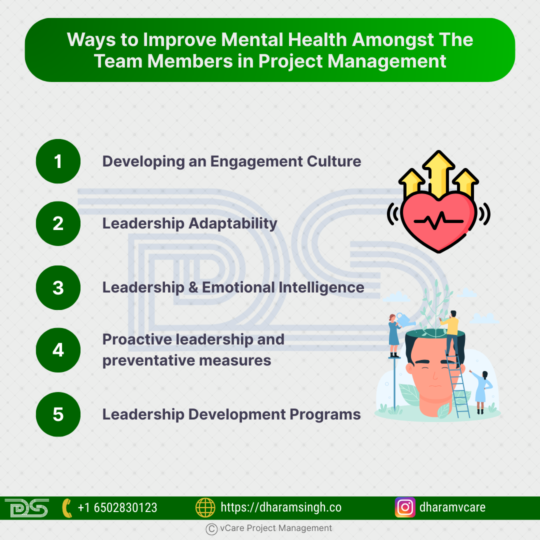
Effective leadership goes beyond task management. Learn five ways project leaders can nurture mental health and build resilient, thriving teams.
1. Developing an Engagement Culture
Leadership principles have a significant impact on a team’s culture. For example, democratic and transformative leaders frequently promote an environment of transparency and participation. These settings foster initiative and idea sharing among team members, which can boost their commitment to project results and job happiness. Effective communication, mutual support, and a shared goal are all characteristics of engaged teams that lower the risk of burnout.
2. Leadership Adaptability
The flexibility of leadership styles is a crucial element that isn’t specifically addressed in the table. In order to better address the demands of their team under changing conditions, effective leaders frequently combine aspects of several styles. For instance, in order to swiftly establish precise goals and standards in the early phases of a project, a more autocratic approach may be required. Including democratic components can assist the team stay engaged and motivated as the project moves forward, lowering the stress and powerlessness that cause burnout.
3. Leadership & Emotional Intelligence
In order to manage stress and avoid burnout, leaders must possess emotional intelligence. Emotionally intelligent leaders are able to identify the psychological and emotional requirements of their team members. They are skilled at adapting their support, encouragement, and communication tactics to the moods of the team and the individual. This skill is especially helpful in high-stress situations when customized support may reduce tension before it becomes burnout.
4. Proactive leadership and preventative measures
The goal of proactive leadership is to foresee certain stressors and put plans in place to lessen them before they have an adverse effect on the team. By proactively identifying the symptoms of burnout, leaders may reduce stress by adjusting workloads, project scopes, and deadlines. Furthermore, providing tools for mental health assistance, such as stress management classes and access to counseling, may improve team well-being.
5. Leadership Development Programs
Project managers and leaders may successfully modify their management style to meet the demands of their team by investing in leadership development programs. The range of conflict resolution, emotional intelligence, stress management, and leadership styles should all be included in these programs. A more thorough knowledge of how leadership affects mental health might help organizations better equip their leaders to build wholesome, effective teams.
Many people still fail to recognize the intensity of stress at work, concentrating only on results and ignoring the human factor. Project managers who are unable to adequately manage workload risk not only team burnout but also leadership failure.
Including Mental Health Wellness Techniques in Project Management
· Proactive Mental Health Initiatives:Implementing proactive mental health efforts, including as wellness programs, stress management seminars, and routine mental health check-ins, can aid in the early detection and treatment of mental health and stress-related problems.
· Flexible Work Schedules:Promoting remote work and flexible work schedules may greatly lower stress, enhance work-life balance, and, consequently, improve mental health.
· Systems for Acknowledgment and Compensation:A more balanced attitude to work is encouraged by putting in place procedures that acknowledge and reward both results and good work habits, which highlights the significance of mental health.
Project managers are tasked with protecting their team’s mental health, preventing stress and fostering a productive work environment. They must prioritize their teams’ mental and emotional health above any project milestone. By broadening their focus to include these crucial components, project managers can ensure their teams are not only successful but also content and healthy in their work environments, ensuring a healthy and productive work environment.
Toolkit for Project Managers and Teams on Mental Health
Building a Mental Health Toolkit for company employees entails gathering tools and tactics to promote workers’ mental health.
Here are some essential components to incorporate:
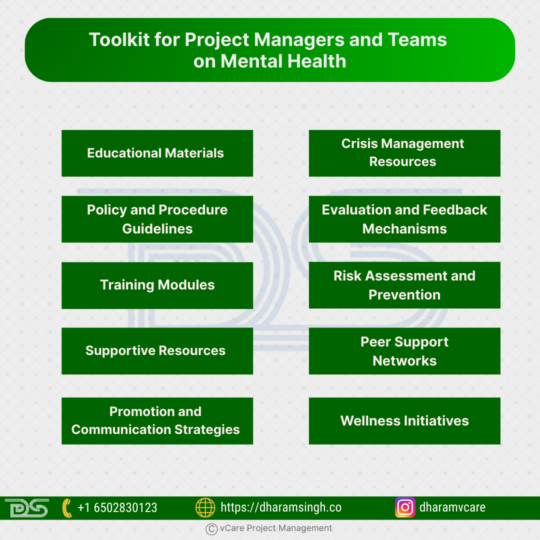
Equip your project team with the right tools. This mental health toolkit empowers leaders to build supportive, resilient, and high-performing workplaces.
1. Educational Materials: This document provides information on mental health disorders, workplace stigma reduction, stress management resources, resilience building, and self-care.
2. Policy and Procedure Guidelines: Sample policies for mental health support and accommodations, workplace crisis handling procedures, and guidelines for confidentiality and privacy regarding mental health issues.
3. Training Modules: Training sessions for managers and employees on mental health, communication skills, empathy, active listening, and promoting work-life balance are being conducted to prevent burnout.
4. Supportive Resources: This document provides contact information for mental health professionals, EAPs, helplines, referral pathways for counseling, therapy, or psychiatric services, and information on insurance coverage for mental health treatment.
5. Promotion and Communication Strategies: This document provides materials for raising mental health awareness, communication strategies for promoting initiatives, and platforms for sharing success stories, testimonials, and best practices within an organization.
6. Crisis Management Resources: This document provides protocols for handling workplace mental health emergencies, emergency contact information, and immediate support and follow-up care for employees in crisis.
7. Evaluation and Feedback Mechanisms: The toolkit involves surveys for feedback on mental health initiatives’ effectiveness, monitoring metrics like absenteeism and turnover rates, and regular reviews and updates to the toolkit based on feedback and organizational needs.
8. Risk Assessment and Prevention: This document provides tools for assessing workplace stressors, strategies for preventing bullying, harassment, and discrimination, and resources for promoting psychological safety and inclusion.
9. Peer Support Networks: The text suggests implementing peer support systems, training employees to offer mental health guidance, and promoting open discussions and forums for employees to discuss challenges and coping strategies.
10. Wellness Initiatives: Programs promoting physical activity, healthy eating, and sleep hygiene, as well as supportive work environments like flexible schedules and remote work options, are essential for a healthy lifestyle.
Real-world examples of organizations successfully addressing mental health
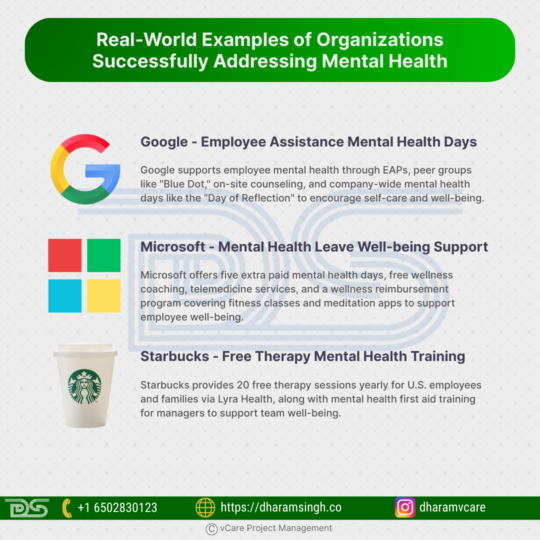
From Google to Nike—these 10 companies are redefining how workplace mental health is approached through proactive, supportive, and sustainable practices.
1. Google – Employee Assistance & Mental Health Days
Employee Assistance Programs (EAPs), peer support groups like “Blue Dot” where employees may openly discuss mental health concerns, and on-site counseling services are just a few of the mental health initiatives that Google has implemented. It also organizes company-wide mental health days, such as the “Day of Reflection,” to motivate staff to prioritize their health and take breaks.
2. Microsoft – Mental Health Leave & Well-being Support
In order to provide employees more time to concentrate on their mental health, Microsoft provides five extra paid mental health days annually. They offer free access to mental wellness coaching for employees and treatment via telemedicine services. Microsoft also offers a wellness reimbursement program that pays for things like exercise classes and meditation applications that promote mental and emotional well-being.
3. Unilever – Mental Health Champions & Flexible Work
Unilever has created a global network of Mental Health Champions, which consists of trained staff members who provide peer support and help create a psychologically safe workplace. They promote “agile working” as well, which enables employees to design flexible work schedules that accommodate their needs for both personal and mental well-being.
4. Deloitte – Mental Health Ambassadors & DE stigmatization Campaigns
Deloitte has taken the lead in addressing workplace mental health by appointing mental health champions and initiating awareness campaigns to reduce the stigma attached to discussing mental health. Their “This is Me” initiative encourages employees to submit personal stories regarding mental health in order to foster an open and supportive work environment.
5. Starbucks – Free Therapy & Mental Health Training
Through the Lyra Health platform, Starbucks offers 20 complimentary therapy sessions annually to all U.S. employees and their families. Additionally, the company provides shop managers with mental health first aid training, enabling them to identify symptoms of distress and provide team members with the right kind of assistance.
6. PwC (PricewaterhouseCoopers) – Mental Health Coaching & Well-being Apps
By providing subsidized therapy sessions and one-on-one mental health coaching, PwC has incorporated mental health into its overall well-being plan. Additionally, employees have access to applications for mental health like Headspace and Thrive, which offer stress-reduction techniques, mindfulness training, and guided meditation.
7. Accenture – Employee Assistance & Resilience Training
Comprehensive Employee Assistance Programs (EAPs) from Accenture include mindfulness training, round-the-clock counseling, and individualized mental resilience training. Additionally, they have a “Truly Human” campaign that highlights the value of mental health and self-care in a high-achieving workplace.
8. Johnson & Johnson – Holistic Mental Health Approach
With an emphasis on physical, emotional, mental, and spiritual well-being, Johnson & Johnson incorporates mental health into their “Energy for Performance” program. Employees have access to mental fitness training, on-site mental health counseling, and company-sponsored mindfulness and meditation programs.
9. Salesforce – Mindfulness Rooms & Employee Well-being Grants
Salesforce supports workplace mental health by providing employee well-being grants that enable staff members to receive financial assistance for mental health services like coaching, therapy, or wellness retreats, as well as by creating “Mindfulness Zones,” which are quiet areas in offices where staff members can meditate or take breaks.
10. Nike – Global Mental Health Training & Paid Rest Days
Nike started a program called “Mental Health First Aid” to teach employees and managers how to identify and handle mental health issues. In order to minimize burnout and promote mental recuperation, they also instituted paid rest days for the whole organization, such as a full week off for corporate workers.
Strategies for a Balanced Approach in Project Management
So, from all the real-world examples of organizations successfully addressing mental health, an effective project management is now crucial for businesses to keep ahead of the competition in the increasingly complicated and competitive business sector. The capacity to properly manage a project is crucial to its success, regardless of its size.
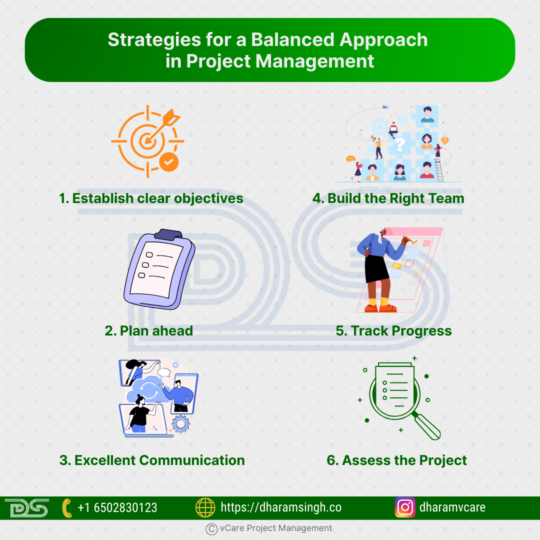
A successful project isn’t just about deadlines—it’s about clarity, teamwork, communication, and care. Here’s how to strike the right balance.
· Establish clear objectives: Having well-defined objectives is important for effective project management. Make sure that everyone engaged is aware of the project’s goals and that they are clearly defined.
· Plan ahead: Developing a strategy that details the actions necessary to accomplish your project’s objectives is the next stage. Create backup plans to deal with any obstacles that may arise. A project’s budget, schedule, and necessary resources should all be included in a solid plan.
· Excellent Communication: The keys to successful project management is excellent communication. Continually update all stakeholders on the status of the project and any modifications to its scope or schedule. Organize frequent check-ins or meetings to make sure everyone is in agreement.
· Build the Right Team: The team that works on a project has a big impact on its success. For each activity, make sure you have the appropriate individuals with the requisite training and expertise. Promote cooperation and teamwork to create a happy workplace.
· Track Progress: Monitoring progress is crucial to making sure the project is proceeding as planned and that objectives are being fulfilled. To monitor developments, spot any bottlenecks, and make necessary corrections, use project management software.
· Assess the Project: After the project is finished, spend some time assessing its effectiveness. Determine what needs to be improved, then make the necessary adjustments for next projects.
Conclusion
In project management, mental health is not only a primary issue, rather it is a critical component that affects team output, performance, and project success as a whole. The necessity for project managers to provide a supportive atmosphere where team members feel heard, respected, and capable of managing stress has been highlighted by the increased awareness of mental health issues in the workplace.
Project managers need to think about these important concerns in order to address these challenges:
· How to successfully strike a balance between team well-being and high performance standards in order to avoid burnout?
· What techniques may employ to foster a psychologically healthy workplace?
· What is the effect of emotional intelligence on a project manager’s capacity to encourage team morale and motivation?
· What part does risk management play in recognizing and reducing mental health risks?
· How to help teams who are dealing with unpredictability and short timelines become more resilient and adaptable?
The first step in addressing the influence of mental health on both individuals and teams in project management is to comprehend why it matters. Burnout, short deadlines, and a poor work-life balance are common issues that can lower morale and productivity. This emphasizes how important it is for project managers to foster an environment of open communication, psychological safety, and proactive assistance.
In order to enhance the well-being of team members, businesses need to put into practice useful tactics, such as mental health toolkits, organized support systems, and training courses that enable managers to identify and successfully handle mental health issues. Furthermore, a comprehensive strategy that incorporates flexible work arrangements, stress management programs, and practical project planning is needed to strike a balance between project needs and employee well-being.
Organizations have shown that prioritizing mental health initiatives leads to stronger teams and better project outcomes. By embedding mental health awareness into project management practices, organizations can create a healthier, sustainable work environment that benefits both employees and project success. Fostering a culture of mental well-being should be an integral part of the project leadership.
#ProjectManagement #MentalHealthAwareness #TeamWellbeing #BurnoutPrevention #LeadershipDevelopment #vCareProjectManagement #DharamSingh #PMICertification #ProjectSuccess #EmployeeSupport #WorkplaceWellness #LeadershipMatters #HealthyTeams #MentalHealthToolkit #EmotionalIntelligence #FlexibleWork #CorporateCulture #StressManagement #ProjectLeadership #WellbeingAtWork
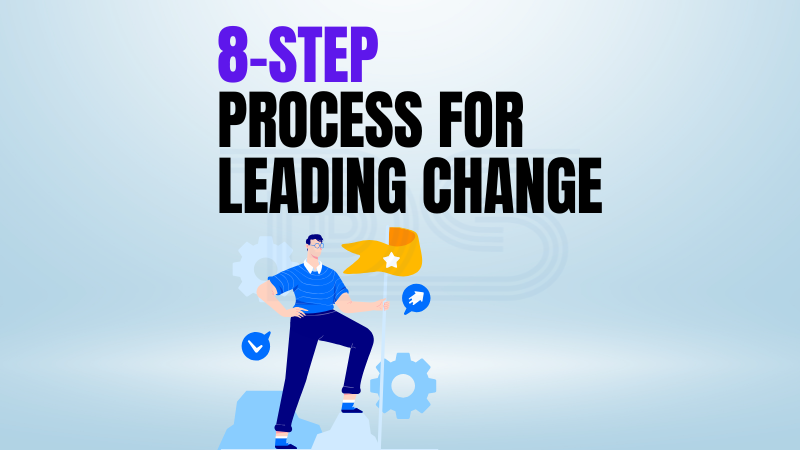










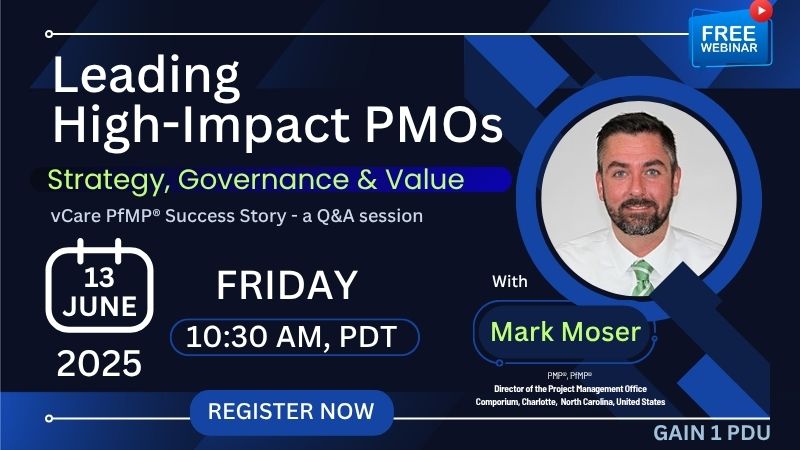

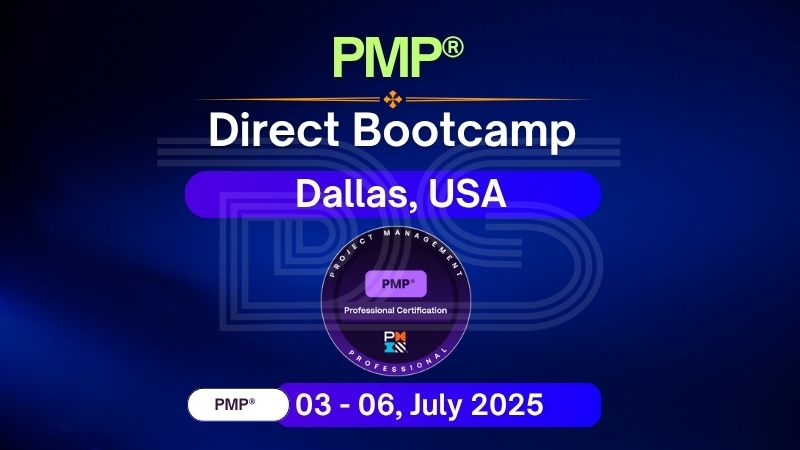

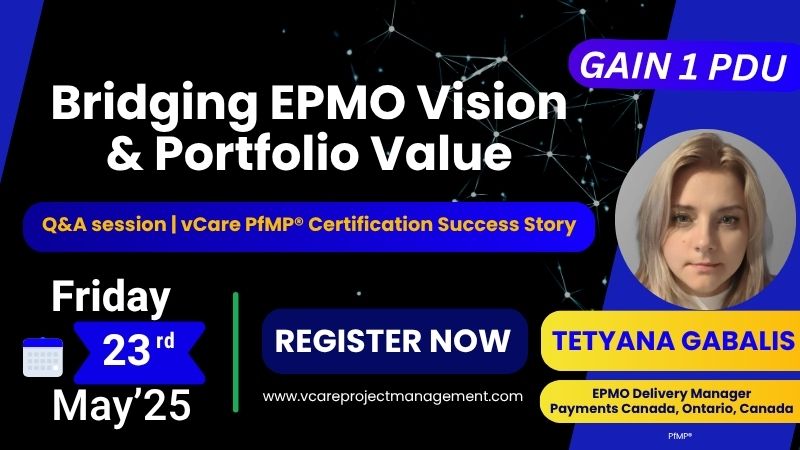

Recent Comments